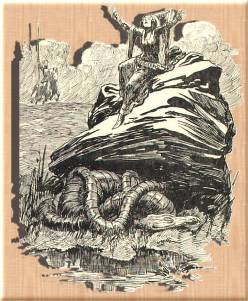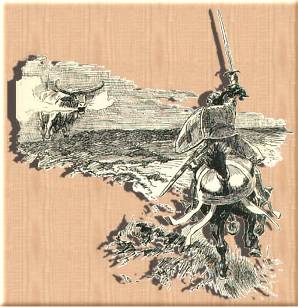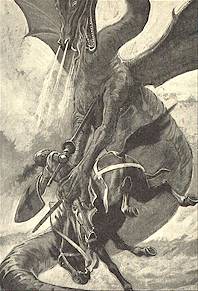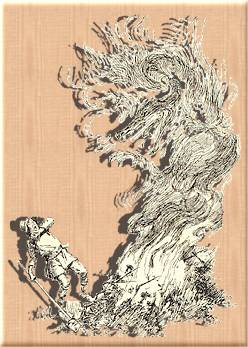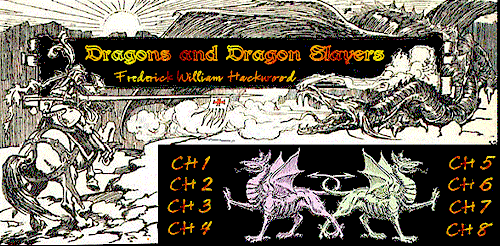
![]()
CHAPTER SEVEN
~ The Dragon in
Literature ~
![]()
|
THE dragon always used - consciously or unconsciously - as a symbol, has found its way into almost every branch of literature, not omitting the Holy Scriptures and the sacred books of intellectual paganism. Nor has it failed to find its way into history - that is, "history as it is made," or into the heavy tomes of sober so-called "science." The credulous compiler of the Annals of Winchester records, under the date A.D. 1177, that "in this year dragons were seen of many in England." About the year 1540 Aldrovandi, Professor of Natural History at the University of Bologna, wrote a history of dragons, a work to which Gesner, Professor of Natural History at Zurich about the same time, assented and subscribed. How real dragons were to the mediaeval mind may be judged by the solemn statement in the Legends and Lives of the Saints, that during the flight of the Holy Family into Egypt, "lions and dragons" came forward to pay homage to the infant Jesus.
The old English ballads which profess to chronicle the exploits and sing the praises of the national patron saint are too numerous to name. One of these quaint compositions tell us that - "When
many hardy Strokes he'd dealt Old Aubrey, the seventeenth-century antiquary, may have been a believer in the calumny which Gibbons the historian subsequently put on record, by the tone of the rhyme in which he expresses himself : "To
save a mayd Saint George the Dragon slew, A much more ancient and therefore more typical rhyme commences the story in the real heroic vein, thus : "A
Dragon great and grimme There was nothing sceptical, nothing half-hearted, in the genuine ballad of ancient minstrelsy. Among all the knightly heroes of old romance none is more conspicuous for deeds of dauntless daring, in every possible form of gallantry, than the legendary Guy of Warwick. He not only led forlorn hopes against the heathen Danes, who in the reign of Athelstane grievously infested this country, but he fought the pagan Saracens abroad, always battling against great odds and always emerging from the contest with added glory to his illustrious name. He rescued fair ladies in distress ; and as a matter of course, in the narrations of the romancists and troubadors, he fought and vanquished terrible dragons, to say nothing
From his numerous victories over giants and other formidable enemies he was honoured in song and ballad as the English Hercules : "'Twas
thy Herculean hand, which happily destroy'd sings the Elizabethan poet, Michael Drayton. Like the boar he slew at Windsor, the dragon that he went against and utterly vanquished in Northumberland was "a monstrous wyld and cruell beast, of passing might and strength" ; a horrible creature "black as any cole, with lion's paws, wings, and a hide no sword could pierce." Nor was this his first achievement of the kind. Soon after he had slain the Soldan himself in single combat - this was while he was on his campaign in Byzantium and the East - his ship was becalmed in harbour, so he went hunting in a neighbouring forest to provide himself with vension. In the forest he came across a lion and a dragon fighting, and resolved to watch the combat, and then engage the conqueror. The dragon won ; Guy then challenged the dragon, and after a fiercely contested engagement bore down the stubborn brute, and finally dispatched him. Whereupon the lion came up fawningly, and lay at the feet of the doughty champion. Guy, Earl of Warwick, was not only one of the brightest flowers of English chivalry, but evidently one of the most accomplished of dragon slayers. Even the king of beasts acknowledged his prowess in this paramount form of fighting. The poet Spenser, who lived in Elizabeth's reign, in the early part of Shakespeare's time, wrote the beautiful poem called the Faerie Queene, of which a brief and bare outline may be given here. The leading character is Una, a beautiful damsel, the personification of Truth. She appears before us as rising upon a white ass and leading a gentle lamb ; she is on her way to the court of the fairy queen, Glorianna, there to seek and enlist the services of a champion who will slay the destructive dragon, the most horrible ever seen, by whom the king and queen, her mother and father, had been carried off and made prisoners in a strong castle. The Red Cross Knight, the most famous in the land, was accordingly sent with her. Once when separated from her champion, so kind and gentle was she, a lion came and fawned upon her and became her constant companion. One adventure of many others on the way was the killing of a seven-headed serpent ; but the greatest was the encounter with the huge dragon which, half walking and half flying, rushed at the champion. Its gigantic body was covered with brazen scales ; its great wings were like two sails, having at the tip of each a many-pronged claw ; in its mouth were three rows of pointed teeth, while its immense tail lay curled in a hundred coils.
that he gave a roar of agony, and snapping at the weapon with his claws, pulled out the barbed head with such violence that the blood rushed forth with a torrent sufficient to turn a water-mill ; while the rage and pain of the wounded dragon were shown by the enormous flames of fire that gushed from its mouth. Then with lightning speed he coiled his great tail round the horse's legs, and brought both the animal and his rider to the ground. Instantly the knight was on his legs again, showering blows on the brazen scales of the dreadful beast. Though he could not pierce that scaly hide, the knight noticed that his enemy was unable to rise from the ground by reason of his wounded wing ; yet the scorching flames that came from the creature's mouth prevented him from approaching near enough to deal him a deadly blow. Being half blinded by the scorching and poisonous flames, the knight was knocked into a well that lay behind him. The dragon thought the fight was over ; but the well happened to be the Well of Life, which cured all hurts and healed all wounds. Una, who was watching the fight from the top of a neighbouring hill, also thought the end had come. Yet faithfully she kept watch all night, and was amazed in the morning at earliest dawn to see the champion rise from the well, fairer and mightier than ever. Without a moment's hesitation the Red Cross Knight rushed once more upon his enemy, who had gone to sleep thinking the victory had been won. Taking his sword in two hands, he drove it right through the brazen scales deep into the dragon's skull ; he then cut off the terrible tail from the body. In vain the monster roared and struggled ; and though he rose to his feet and laid about him as heavily as before, darting his head forward over and over again with wide-open jaws to swallow his assailant, he could gain no advantage. At last the knight, avoiding the snapping jaws, sprang nimbly on one side and thrust his sword right down that yawning gulf of a mouth, right up to the hilt, and so gave the creature his death-blow. The victor himself trembled ; and it was long ere Una dared draw near to her hero, dreading lest the foul dragon should stir to life again. But he was indeed dead ; and right joyfully they set forth to tell the king and queen that the dragon was slain, and that they were free. At the great news the trumpets sounded, the people assembled, and public rejoicings were held to celebrate the destruction of the awful pest which so long had troubled the land. A mighty procession was formed, headed by the grateful king and queen, who came to lay the laurels of victory at the feet of the Red Cross Knight, who married the Princess Una ; and so all ended happily. In this story, the beauty of which can only be realised by reading it in Spenser's own words, it will be again noted that the dragon is created merely to be - slain ! How a number of dragon-myths have originated is well illustrated in the case of the great Italian poet Petrarch. At Avignon, where, in the fourteenth century, he was long associated with the Papal Court, and where he was inspired by his passionate love for the beauteous Laura, is a church on the portal of which is a sculptured representation of St. George and the Dragon. From these two simple facts the renown of a dragon killer has been conferred on the poet. According to the story invented, as Petrarch and Laura were one day hunting, they chanced to pass the den of a dragon, when the hideous monster rushed out and attacked Laura. Petrarch instantly sprang to her assistance and promptly dispatched the foul beast with his hunting-knife. If the tale is doubted, the narrator triumphantly points to the sculpture as proof of its authenticity ; just as a painting of a dragon on the wall of Mordiford church, in Herefordshire, has for centuries been pointed out as the representation and memorial of a monstrous reptile killed in the adjacent River Lugg by a condemned criminal. In mediaeval times the dragon was as much a reality as is to-day any rare beast known to be in a zoological collection. In the popular mind it was just the limit in horrent, hideous reptilian creation. So frequent and so familiar was the use of the dragon in early literature, it is not surprising that the features and the attributes of the fabled creature because standardised - the conventional dragon is always an absurdly impossible animal. He was a horrible, rampant, raging beast in scaly armour, having a long, coiled, and barbed tail, terrible claws, and bat-like wings, and displaying fierce poisonous fangs through which he has a propensity to breathe scorching flames calculated to destroy the very souls of humanity. With a foe so formidable, a stand-up fight could not be otherwise than thrilling - as in the story of Una's Red Cross Knight. As to "the reason for its being," the dragon was a creation, when figurative language was prevalent, to symbolise a great evil or an overwhelming calamity ; a something which could be overcome only by a self-sacrifice of the most devoted and heroic character. In another aspect the dragon became the symbol for perfect guardianship ; vigilant, unswerving, and unfailingly reliable. The typical guardian of classic mythology was assuredly that sleepless dragon who guarded the golden apples in the Garden of the Hesperides ; who, as the poet puts it, "watched and abstained." All our knowledge of the subject comes to us from legend and myth. A legend is not an artificial composition ; that is to say, it is not entirely fiction, but always has some basis of fact, however small, feeble, and remote, to rest upon. Now, in all the old tales of dragons and their vanquishers, be they pious saint or knightly champion, it is clear that the underlying basis of fact will lie not so much in the symbolic dragon particularised, as in the character of the conquering hero ; for in this is found the spring of action, the one inspiring motive of the allegory, the traditional narrative of heroic and memorable achievement. So repelling to human nature are most representatives of the reptile family, and perhaps none more so than the crocodile, of all known living creatures the most analogous to the mythical dragon, it requires a spirit as exuberant and a conceit as quaint as that of Lewis Carroll to invest the subject with any tinge of humour ; as thus : "How
doth the little crocodile How
cheerfully he seems to grin, So largely has the dragon idea entered into our life and literature, quite a number of English words and names have been derived from this source. In bygone centuries, when the mysteries of the weather and other physical phenomena were little understood, hurricanes and storms, earthquakes and fiery meteors, were attributed to the influence and actions of evil-spirits such as "flying dragons of the ayre."
call a natural light sometimes seen floating over marshy ground, and which often misleads unwary travellers. Thus an old poet very tragically says : "So
I have seene a fire-drake glide along While as showing the connection between the terms "drake" and "dragon," we may quote the poet Drayton : "By
the hissing of the snake, The idea of a dragon being able to spit out scorching fire and flame is preserved in several of our English words. A "flap-dragon" was an old-time strong drink in which small bodies (eatable) were set alight and floated in the liquor, and the skilful toper has to swallow them blazing hot ; somewhat in the same way as children at Christmas parties play at "snap-dragon" by snapping at blazing raisins in burning brandy to eat them. Soldiers known as "dragoons" were so called because originally these regiments were armed with muskets called dragoons, a kind of gun which spouted out fire and actually had their muzzles fashioned in the shape of a dragon's head. On their helmets they wore a dragon badge. It will be seen what a favourite subject with ancient story-tellers the dragon was by its introduction into so many old tales, legends, and romances. And then there was the funny tale of the giant who used dragon-flesh for bait when he went a-fishing : "His
angle rod made of sturdy oak ; We have a way of speaking proverbially of "dragon's teeth," representing them as the seed of strife, as something which is sown and in due time grows up as men armed for deadly warfare. The idea is borrowed from Greek mythology, in which we read that Cadmos slew the dragon that guarded the Well of Ares, and then sowed some of its teeth, from which sprang up men called Spartans, who all killed each other except five, who became the ancestors of the Thebans. Those teeth which Cadmos did not sow came into the possession of Ĉetes, King of Colchis, who enjoined upon Jason, when he set forth upon his tasks, to sow these teeth and not neglect to slay the armed warriors who grew therefrom. The idea underlying the phrase, "sowing dragon's teeth," is that of pursuing some line of action that must eventually lead to armed conflict. Quite a number of English place-names contain the word "worm" as Wormbridge, Wormsley, Wormside, Wormhill, and Wormhlaew (Wormelow). There is a similar group of names in part of Derbyshire. Other examples occur elsewhere, and there is a River Worm, a name that in this instance may be allusive to a winding course. The word "worm," although cognate with the Norse ormr, "a serpent," seems in early and mediaeval times to have meant a reptile of almost any kind, doubtless from the kind of motion common to most animals of the class. The real serpent and the legendary dragon were, until the revival of classical learning, included under the common phrase the "cruelle worme," as many of our ancient English ballads show. In Merlin's Prophecy "a worm with fiery breath" was among the threatened plagues. |
